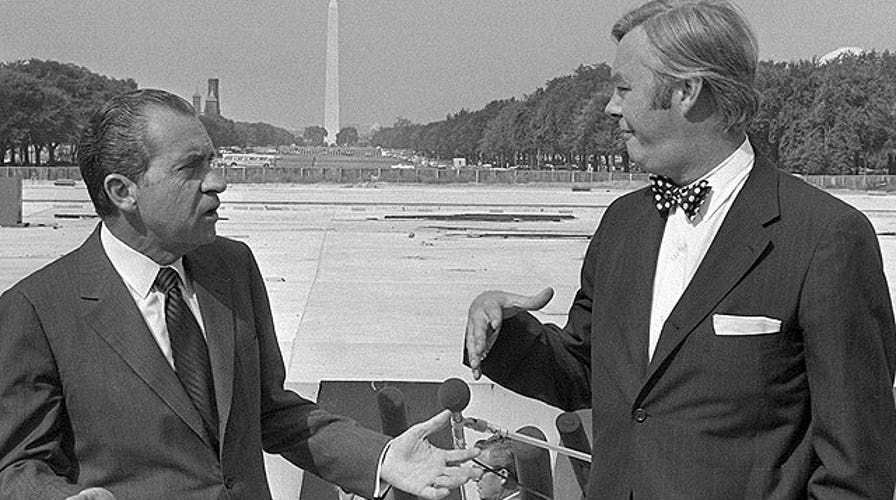The Foxhole: Stephen Hess on Moynihan and Nixon
Author Stephen Hess discusses his book, 'The Professor and the President: Daniel Patrick Moynihan in the Nixon White House'
On December 10, 1968 – after winning the presidency with just over 43 percent of the popular vote, his margin of victory over Hubert Humphrey, the Democratic nominee, less than a percentage point – President-elect Richard Nixon announced a curious appointment to his administration. As counselor and assistant to the president for Urban Affairs, Nixon named Daniel Patrick Moynihan, the eminent sociologist from Harvard University – and a well-known Democrat and Kennedy man.
It has taken nearly five decades for Moynihan’s deputy in the West Wing of the Nixon White House, Stephen Hess, to produce a firsthand account of this extraordinary alliance. Now, in his new book "The Professor and the President: Daniel Patrick Moynihan in the Nixon White House" (Brookings Institution Press, 2014), Hess draws on previously unpublished notes and memoranda to flesh out what the author calls “the oddest…of all the odd couples in American political life.”
Expressly for Moynihan to preside over, the president created a new Executive Branch body called the Urban Affairs Council (UAC). Focused on the metastasizing problems of the cities in the late 1960s, the UAC was intended, at least in theory, to serve as a kind of twin to the National Security Council, the foreign policy group then chaired by Dr. Henry Kissinger (who was, like Moynihan, an alumnus of Harvard University: the Ivy League epicenter of Nixon’s fear and loathing of the Eastern Establishment).
What made the pairing so odd – and wound up enhancing Moynihan’s clout during the two years he served on the White House staff, 1969-70 – was that Nixon, a conservative-leaning chief executive, had next to no interest in domestic issues at all, and thus turned over significant chunks of the portfolio to the urbane, bowtie-wearing urbanologist he had just hired.
“I’ve always thought the country could run itself domestically without a president," Nixon had earlier told the journalist Theodore H. White. “All you need is a competent Cabinet to run the country at home. You need a president for foreign policy.”
“From the very moment that he was appointed, before Nixon was even president, Moynihan started to bombard him with memos,” Hess said on “The Foxhole.” “And these weren’t the type of memos that I knew, having been on the Eisenhower [White House] staff, [where] you try and send one page to the president: He’s busy and you’re busy, and that sort of thing. These were long, complicated, complex memos, even about issues the president could do nothing about.
ROSEN: With a certain literary flair to them.
HESS: Oh, absolutely. And what were these? These were intellectual-to-intellectual. And Nixon had never been treated that way before – and he loved it! And what Moynihan found over time was that Nixon was a very smart man.
The substantive policy results of the Nixon-Moynihan collaboration were both fleeting and enduring. Their most ambitious initiative – a plan for a guaranteed federal income for poor households, a shocking deviation from conservative orthodoxy for which the right wing never really forgave RN – never made it out of committee in the Senate. But on other points and areas of focus, Moynihan’s work for Nixon endures.
Detailing what he called “the tangle of pathologies” for African-American families, Moynihan had already achieved notoriety in the early 1960s; and he went on, after the Nixon era, to serve with great distinction as U.S. ambassador to the United Nations and as the only Democratic senator from New York to serve four full six-year terms (succeeding him in that seat was a little-known first-time candidate named Hillary Clinton).
But the time Moynihan spent rubbing elbows with Haldeman and Ehrlichman, John Mitchell and George Shultz, may have witnessed the apex of the academician’s influence on presidential decision-making. In large part, that influence derived from Moynihan’s legendary Irish charm and wit, and his ability to make Nixon laugh – and think – as few other advisers in his career ever would.
“They built,” said Hess on “The Foxhole,” “a loyalty and a friendship to each other, which turned out to be really quite unexpected – and quite amazing.”

